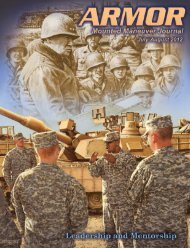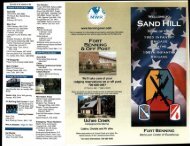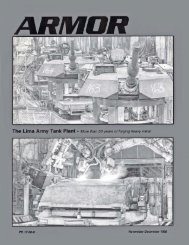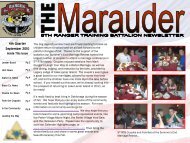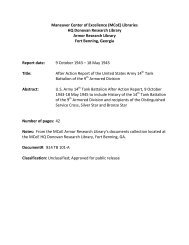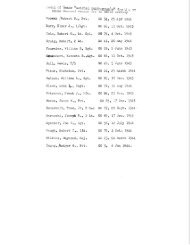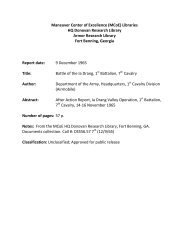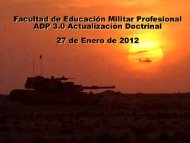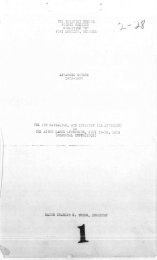ARMOR, September-October 1987 Edition - Fort Benning - U.S. Army
ARMOR, September-October 1987 Edition - Fort Benning - U.S. Army
ARMOR, September-October 1987 Edition - Fort Benning - U.S. Army
Create successful ePaper yourself
Turn your PDF publications into a flip-book with our unique Google optimized e-Paper software.
guage - - was a much larger issue than<br />
expected. The armo?mech force<br />
with emcrience in airborne and<br />
mech weye used extensively.<br />
face-to-face ability to quickly access<br />
the other force’s intelligence,<br />
trained to and was completely con-<br />
maneuver, and fire support systems<br />
versant in FM 71-15 (Draft), The Along with the exchanged liaison was essential in providing positive<br />
Tank and Mechanized Infantry officers, they were essential in ensur- command and control of both<br />
Company Team, and FM 71-21, The ing that units truly understood what brigades and their subordinate task<br />
Tank and Mechanized Infantry the other force meant.<br />
forces.<br />
Task Force. All members of<br />
the 41D team had trained<br />
with this document as their<br />
Alternate Communications<br />
Means - Both brigades had<br />
rcfercnce, while the airborne<br />
different communication sysforce<br />
was generally unfamiliar<br />
tems. The Airborne relied<br />
with it. Upon initiation of<br />
heavily on TACSAT for<br />
coordination for joint exer-<br />
commo links with its task<br />
cises, it became clear that a<br />
force, while the heavy force<br />
common, understandable lan-<br />
primarily relied on FM.<br />
guage was not being spoken.<br />
During one phase of the<br />
Obviously, airborne acro-<br />
operation, the assault CP<br />
nyms and armored acronyms<br />
lost all commo with its paraare<br />
different and were initial-<br />
troopers. Critical intelly<br />
conrusin& but the problem Heavy force tankers had difficulty in vehicle ligence was needed about<br />
went much deeper than that.<br />
identification because the OPFORss visually<br />
the enemy situation in an<br />
During discussion of passage<br />
modified She&,ans resembled the 3,3 Armor,s<br />
objective area, but was unand<br />
link-up operations, it be-<br />
TOE vehicles.<br />
available due to the comcame<br />
apparent that a com- munication lapse. The<br />
mon language was missing. Perhaps<br />
heavy force, using its organic rea<br />
measure of the way the <strong>Army</strong><br />
trans equipment, was able to net<br />
trains its infantry officers, the heavy Lessons Learned<br />
with the attached Sheridan comforce<br />
had several officers who readi-<br />
pany of TF Strike and receive timely<br />
understood light tactics and<br />
methods, but the opposite was not<br />
Command, Control and Communications<br />
- Several of the missensitive<br />
intel information that was<br />
critical for the heavy force. This<br />
true. Although mech-experienced of- sions required that brigade and bat- ability to reinforce or augment each<br />
ficers were doubtlessly in the air- talion command posts be co-located other’s primary communication<br />
borne brigade, their numbers were to ensure positive control of assets, means was an unexpected benefit.<br />
significantly less than the opposite<br />
arrangement.<br />
particularly during passage operations.<br />
The airborne assault CP lo- Use of Liaison Officer - Although<br />
cated with the brigade jump CP and exchange of liaison officers is cer-<br />
Because of this lack of mech/ar- the main CP on two different oc- tainly not a new idea, the utility of<br />
mored experience, graphics, com- casions. During these co-locations, these young officers far outweighed<br />
monly used expressions, and com- the light force CP merely moved their junior grades. While performmon<br />
knowledge items often had to into the heavy CP complete with tac- ing the traditional role of transportbe<br />
carefully explained. In fact,<br />
diagrams and examples from FW 71tical<br />
satellite communications antennas<br />
and remote units to FM radios.<br />
ing orders and overlays and keeping<br />
their force alerted to changes in the<br />
21 were reproduced, annotated, and In one situation, the entire cells for other force’s plans, these officers<br />
used by the light force to brief its both units were placed in a M577, were also called upon to describe<br />
staff on upcoming operations. More with the heavy force radios in the and explain the capabilities ol their<br />
time than expected was consumed<br />
in ensuring that each force undervehicle,<br />
and the light force S3 in the<br />
extension. RE, <strong>Army</strong> aviation and<br />
parent force’s equipment and the<br />
manner in which it would be<br />
stood what the other was saying. Air Force LNOs also located ad- employed. Although previous brief-<br />
Translators in the form of officers jacent to each other nearby. This ings had described some unit<br />
<strong>September</strong>-<strong>October</strong> <strong>1987</strong> <strong>ARMOR</strong> 13



